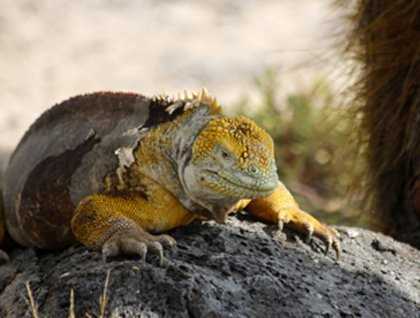South Plaza is one of the islets that lie off the eastern coast of the larger island of Santa Cruz. Both islets, North Plaza and South Plaza, are the result of geological uplift which took place over a million years ago, but only the southern island is open to visitors. South Plaza is home to one of the healthiest remaining land iguana populations in Galápagos. On this small islet, their territories overlap with those of the marine iguanas, and the two separate species have been known to interbreed here, and create a non-viable hybrid which can sometimes be seen during a visit. In the past, some populations of land iguanas have been almost wiped out by feral dogs, but thanks to a successful captive and semi-captive breeding program run by the CDF and GNPS, these endangered populations were able to recover.
The trail of the islet parallels the cliff top where the southeast trade winds provide the up-draft for numerous seabirds. Hundreds of swallow-tailed gulls, Galápagos shearwaters and red-billed tropicbirds are frequently seen in the area, while frigate birds soar overhead, always looking for feeding opportunities. At the end of the trail we reached a sea lion bachelor pad, where impressively-sized beach-masters recover their energies after a long breeding season. On the northern-low section of the trail, the lava rocks have been polished by sea lions over hundreds of years and now you have the impression of walking over huge marble rocks.
Swallowed tailed nesting, cactus finches feeding on the cactus fruits and land iguanas basking on the sun were found everywhere while many sea lion pups were jumping here and there in the water for the delight of all of us.
After lunch we headed south to the island of Santa Fé, to find another species of land iguana restricted to this island and found nowhere else. Here, land iguanas and prickly-pear cacti are spread out over a large area and are hence sometimes more difficult to find. Before, Santa Fé Island was over-run with goats, but thanks to a very successfully eradication program, feral goats have been removed and now the ecosystem of the island is slowly recovering.
After exploring the waters of Santa Fé by kayaking and snorkelling, we landed on one of the beaches of the beautiful bay, where many sea lions were basking on the sun and dozens of young pups were playing here and there.
From the beach, two trails lead inland. A loop trail over boulder terrain along some of the largest prickly-pear cactus trees on the islands, and another trail going up to the cliff with impressive views of the island and the bay. In both we had the chance to spot more than 10 land iguanas with their distinctive green-brown coloration as well as Darwin finches, Galápagos mockingbirds, doves and snakes.









